So how do kiwis grow? Today you'll learn about the kiwi plant and how to grow kiwi plant in a pot. These fruits are mostly grown in California and New Zealand for the most part, and so they need a warm growing medium to fruit. If you live in a warmer area where there is no frost, you can easily grow your own kiwi plant at home!
And the best way to grow kiwi? In a pot of course! No longer does kiwi have to be that fruit you purchase from a grocery store because you can grow hardy kiwi varieties right at home! These “hardy” kiwi variety is actually smaller and sweeter than in-store bought kiwis (meaning they're even more delicious!). They are also called baby kiwis and they grow in clusters. What's even better about these kiwi varieties is that they can sustain colder weather, unlike their grocery store counterparts, and can also be eaten whole!
That's right, baby kiwi varieties, or hardy kiwis, have a very soft and smooth outside that you can consume in its entirety!
How to Grow Kiwi Plants in Pots
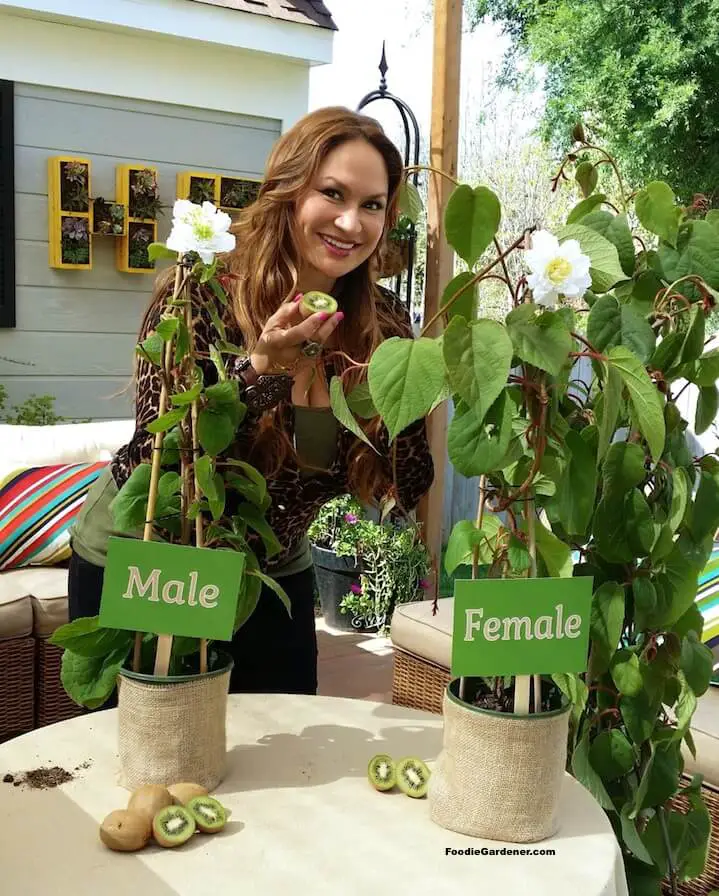
Climate:
Hardy kiwis can sustain and remain dormant in -25C weather, but actually grow in mild winters, so as long as they're taken care of, kiwis can grow almost anywhere! Remember that kiwi vines also need support, so you'll need a climbing pole or a trellis for your kiwi to climb on.
Soil:
- Purchase a soil-less potting mix that has at least one third organic material. Make sure that the potting mix is well draining soil since kiwis do not like standing water.
- Into that potting mix, add organic fertilizer such as bone meal or well composted manure. This will ensure a really health growth medium, and will also help prevent diseasese.
Sun:
Place your kiwi pot in a sunny south or west facing wall if you live in a cooler climate. For warmer climates, place your kiwi pot in full sun.
How to Fertilize Kiwi Plants:
In late winter, mulch with rotted organic matter. In spring, apply an organic well balanced fertilizer, just as new growth emerges.
Kiwi Companion Plants:
You can plant kiwi alongside the following plants: marjoram, lemon balm, and marigold. Be careful as kiwi vines are quite dominant and will need a trellis or stake in order not to spread around in the pot.
Spacing Kiwi Plants:
- Space each single plant 9′ 10″ (3.00mm) each way.
- Space rows 9′ 10″ (3.00mm) with 9′ 10″ (3.00mm) row gap.
Planting Kiwis:
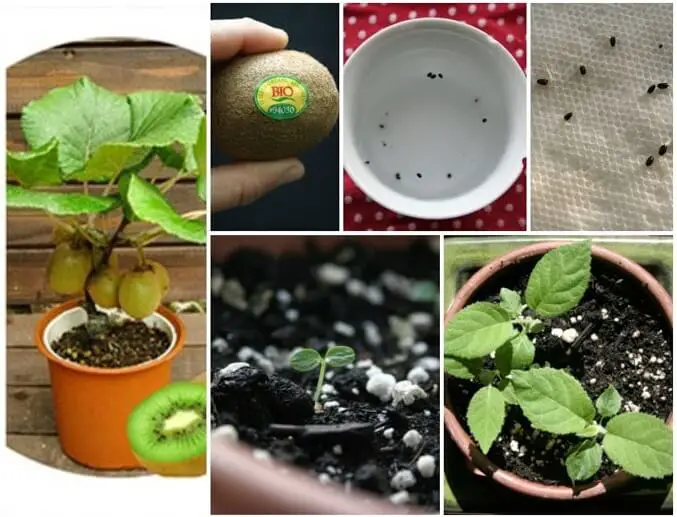
- Start off by purchasing a kiwi nursery container. It is much easier and much more guaranteed you'll have kiwis than if you were to plant them from seed. If you DO decide to grow from seed, just follow the same directions as below!
- Place your nursery container or pot next to a trellis so that your kiwi can climb up. Or, simply use a stake as you would with tomato plants.
- Fill the nursery container about two thirds full with the potting and fertilizer mix.
- Remove the kiwi plant from its container and plant it in the center of the container.
- Take a male and a female plant from the container and place them on each side of the of the centered plant. (Kiwi nursery containers SHOULD contain both a male and a female plant, especially if you're growing the hardy variety!). You'll need female plants for successful pollination!
- Cover up the rest of the container with potting mix until it gets to the top. Leave 2-3 inches at the top for water.
- Stick a stake into the container next to the trellis to facilitate growth and reach.
How to Care for Kiwi Plants:

- You should prune the vines about four times during the growing season. Start by cutting off half the new growth of each branch every few weeks. This will teach the kiwi plant to grow more as a bush than a vine. Limit the growth of the male plant to just flowers – just enough to pollinate!
- Fertilize the plants just before growing begins, and then two or three more times during the first half of the growing season.
- You should pick off your kiwi fruit when they are mature, but not fully ripe. They will ripen on their one once off the plant!
How to Harvest Kiwi Plants:
Pick kiwi plants before the first frost and then let ripen indoors. In warm weather climates such as tropical or subtropical regions, allow the kiwi to just barely ripen on the vine naturally. You'll know they're ready to pick once they are the correct size and color (the same size and color you would find in a grocery store). Pick them off and allow them to ripen indoors.
Kiwi Plant Pests and Diseases:
Be wary of wet soil – kiwifruit is susceptible to bacterial blossom blight, oak root fungus, and Phytophthora (root rot). Additionally, keep an eye out on bleeding canker which is a disease that can affect the kiwi plant in cold winters.
Please be aware that if you do not live in a warm climate, it may be hard to successfully grow kiwis. If growing or moving the kiwi plants indoors, keep them in a warm area with plenty of sun. A south facing window would be ideal as kiwi plants enjoy at least 6-8 hours of sunlight per day.
Now that you know how to grow kiwi in a pot, let's get to it so you can enjoy this amazing tropical fruit all year long!
For more posts on tropical fruit, check out our Tropical Fruit Blog!
Happy Planting!
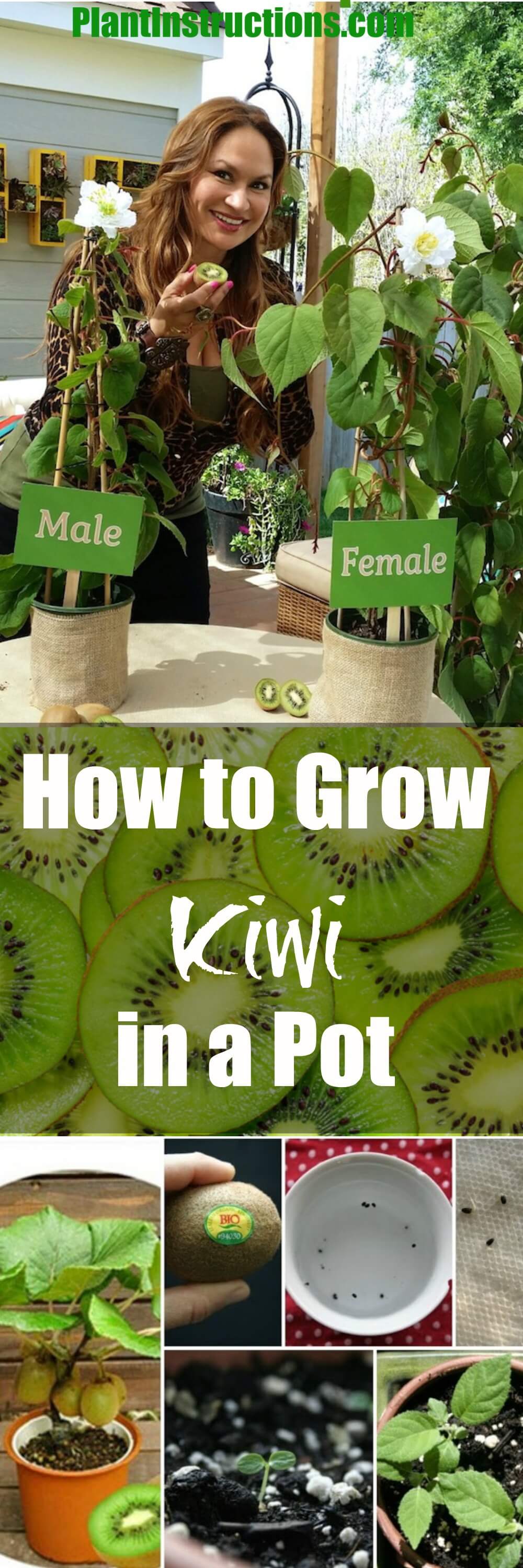

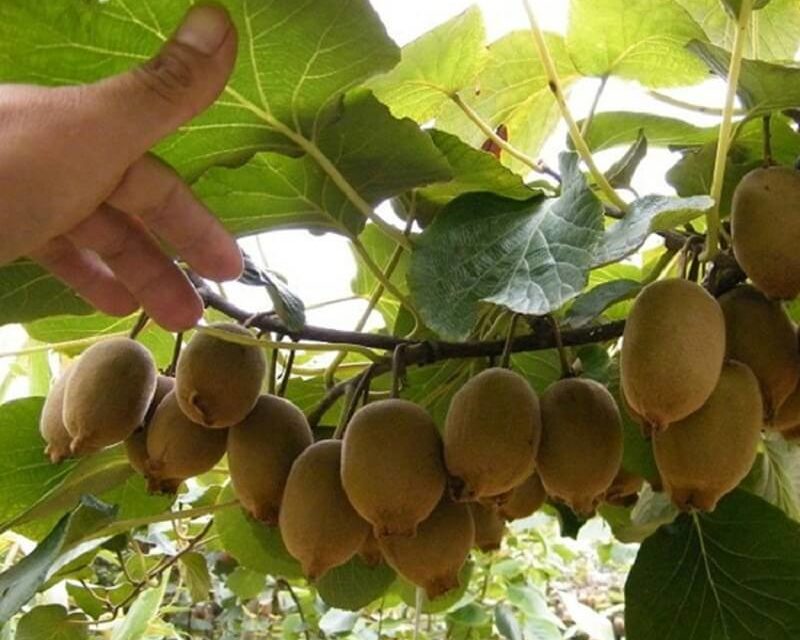


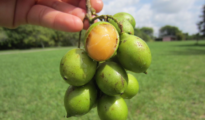















How do I know from male and female kiwi plants
Hi Lolly,
Determine if all the parts in the middle of the flower are yellow, pollen-covered anthers. These are male kiwi plants. Alternatively, notice if the centers of the flowers are filled with white stigmas, along with a few yellow anthers on the edges. These are female kiwi plants.
Hello! I am not sure if I understand the instructions correct, but it reads ” Take a male and a female plant from the container and place them on each side of the of the centered plant. (Kiwi nursery containers SHOULD contain both a male and a female plant, especially if you’re growing the hardy variety!).” So, that does mean you need to get three plants? One female and one male, and what should the third one be?
Hi Linn,
So sorry for the confusion! You just need two plants – one male and one female!
Thanks for picking up that mistake!
How do I figure out which one is male or female?
Thank you
Hi Emi,
Female kiwi plant identification will appear as flowers with long sticky stigmas radiating out from the center of the bloom. Additionally, the female flowers do not produce pollen.
How far apart do male and female plants need to be? Are they ok if the are 25 feet apart?
Hi Cambrie,
Yes, 25 feet apart is great, as long as they’re no more than 50 feet apart, you should be good 🙂
Hi, can you tell female from male kiwi fruit? i want to plant from seeds. Thank you.
Your initial picture shows kiwi seeds. I started my seeds from a store-bought kiwi by the paper towel method. They sprouted after a couple weeks and are now planted and about 25 of them are about 1\4 inch tall. So I’d like to know if I can tell if my seeds are from a male or female kiwi. If you can tell the different sexes from a piece of fruit from the store, then I would know which sex the next piece of fruit I buy is so I will be able to grow fruit. I’ve never seen kiwi plants… Read more »
I’m overwintering my hand grown kiwi plants. Now they are in my office and I have a humidifyer going in the room. One vining Kiwi plant was downstairs and his/her leaves started to wither so I thought they all could use more moisture in the leaves. When they were seedlings I misted them daily and they liked that. Then during the summer they all five remainting went outside a good 8 feet apart. As I said now I’m overwintering them all in one room with ample sunlight. I want them to survive the winter so I can repot them outside… Read more »